
- Sustainable Planet -
- 12mins -
- 544 views
Meet ‘Manta’—the Sea-Cleaning Sailboat that Collects up to 3 Tons of Ocean Garbage per Hour
‘Manta’ is the first concentrated ecology and technology factory ship capable of collecting, processing and recovering large quantities of marine plastic waste —and it’s powered by renewable energy.
THE SEACLEANERS PRESENTS THE MANTA
The SeaCleaners unveils the Manta, its pioneering and ecofriendly sailboat to collect and process large quantities of marine plastic waste. The Manta is an ecofriendly sailboat, operating autonomously at 75% without fossil fuels – an unprecedented technological feat. This multi-purpose factory boat, propelled by renewable energies, embodies a new way of acting to protect the oceans.
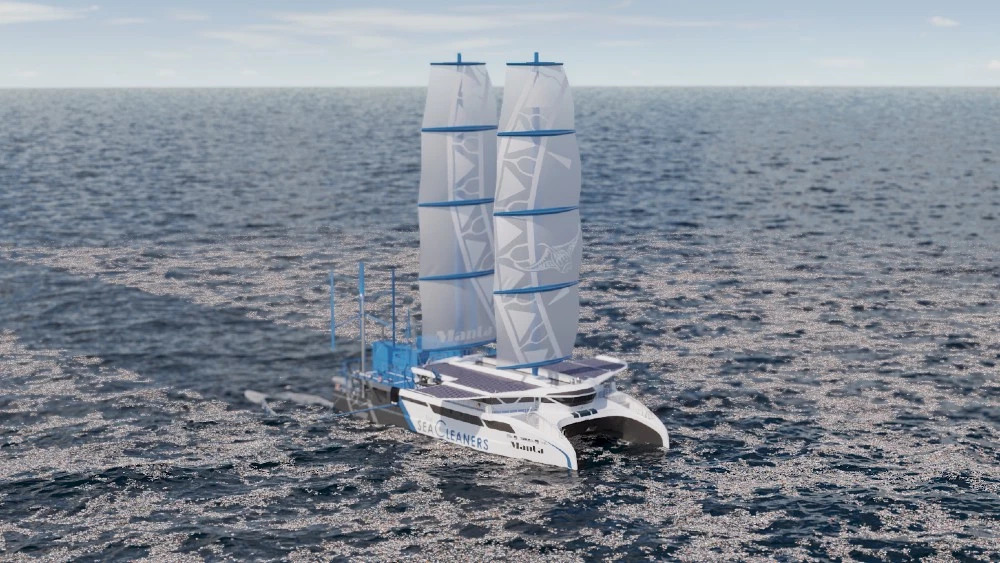
Multi-purpose vessel This extraordinary ship will also serve as a cutting-edge scientific laboratory for the observation, analysis and understanding of ocean plastic pollution and as an educational platform open to the public. Source: TheSeaCleaners.org
Giant plastic-eating catamaran will be launched in 2024
Three years of research and development resulted the Manta, a giant catamaran, the first factory boat designed to collect and process large quantities of floating plastic macro-waste at sea.
Its biomimetic design, innovative hybrid propulsion system and power supply from renewable energy sources will enable the Manta to operate 75% of the time autonomously, without using fossil fuels, with a minimal environmental footprint.
This extraordinary ship will also serve as a cutting-edge scientific laboratory for the observation, analysis and understanding of ocean plastic pollution and as an educational platform open to the public.
The Manta will be launched in 2024.
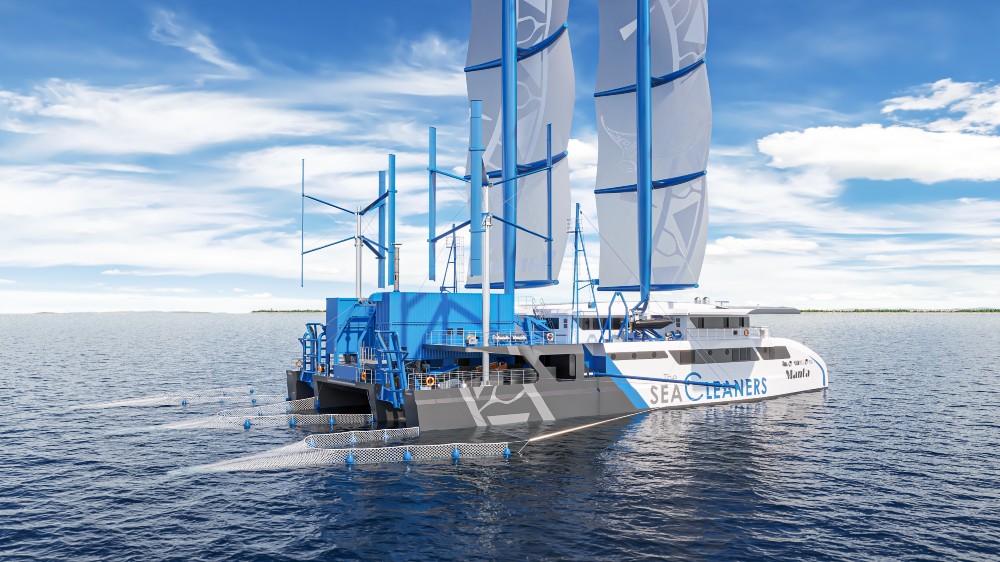
Manta has nets along the stern to collect plastic and garbage, along with sustainable energy sources like solar panels and wind turbines to power the onboard collection and recycling center. Source: TheSeaCleaners.org
Manta will be the only workboat capable of managing 100% of the plastic waste collected at sea
Every minute 17 tons of plastic are dumped in the oceans… amounting between 9 to 12 million tons each year. According to the United Nations (UN), if ambitious actions are not taken, then oceans will contain more plastic than fish by 2050.
Yvan Bourgnon – adventurer, champion and record-holding navigator – was tired of hitting floating objects during competitions and seeing paradise turned into a dump. He decided to take action.
How? By creating the association The SeaCleaners and setting up a centre of expertise dedicated to the construction of a pioneering ship: the Manta, the first sea- cleaning boat capable of collecting floating plastic waste on an industrial scale.
Thanks to a unique combination of collection means, the Manta will be able to collect both floating macro-waste and smaller debris from 10 millimetres upwards and up to one metre deep.
A world first: the Manta will be the only workboat capable of managing 100% of the plastic waste collected at sea thanks to its onboard factory. It will be sorted manually, treated and recovered using a pyrolysis energy conversion unit capable of converting all the plastic collected into energy with a minimal environmental footprint. With a waste collection and processing capacity of 1 to 3 tons per hour, the Manta’s objective is to rid the oceans of 5,000 to 10,000 tons of plastic waste per year.
Source: TheSeaCleaners.org

Two rear tenders Mobula 8 and Mobula 10 will clean up trash in shallower waters. Source: TheSeaCleaners.org
How it works
The propulsion of the vessel will be provided by a customised hybrid system combining 1,500 m2 of sails installed on automated rigging and electric motors. Electricity will be produced by a series of on-board renewable energy production equipment (two wind turbines, hydro-generators, almost 500 m2 of photovoltaic solar panels) and by an on-board waste to energy unit. This unique and innovative system will enable the Manta to operate autonomously on average 75% of the time, without using fossil fuels, with an environmental footprint reduced to the strict minimum.
In addition to its vocation as a “cleaner of the seas”, three other missions are assigned to the Manta, making the ship a complete solution for combating plastic pollution, both corrective and preventive.
- 1. In co-development with local decision-makers, to contribute to the transition towards a circular economy in countries affected by plastic pollution, by demonstrating and disseminating innovative solutions for the management and treatment of plastic waste and clean shipping solutions for “green ships” and “smart ships”;
- Receiving the public aboard for awareness and education actions on plastic pollution ;
- To host international scientific missions, thanks to its on-board research facilities, on the quantification, characterisation and localisation of plastic waste slicks. The data collected will be shared in open Data.
The Manta will intervene mainly in Asia, Africa and South America, on strategic sectors where marine plastic pollution is particularly dense: coastal areas, rivers, large rivers mouths and estuaries. A deep-sea vessel, the Manta will also be capable of intervening rapidly in polluted areas following a natural or climatic disaster (typhoons, tsunamis…).
A technical consortium of some twenty companies and five research laboratories are at work on the design and development of the boat. The selection of the shipyard that will build the Manta will take place in 2021, the launch and the first collection campaigns will take place in 2024.
Source: TheSeaCleaners.org

The sailing cat plans to collect 10,000 tons of ocean trash each year. It will also be able to house marine biologists doing ocean research. Source: TheSeaCleaners.org
THE MISSIONS OF THE MANTA
Beyond the Manta’s principal mission of “cleaning the seas” and repurposing plastic, the Manta is assigned other missions, making it a complete and unique solution to combat plastic pollution.
An educational platform – a vector of awareness and prevention
After 3 weeks at sea collecting plastic waste, the Manta will visit coastal ports in the area to raise awareness, educate and present the The SeaCleaners missions. Each day in port, the Manta will welcome the public aboard for conferences and activities regarding plastic pollution. A dedicated area of 200 m2 and a conference room for 80 people are on-board the Manta to accommodate these events.
A tool to promote the circular economy
The Manta, itself, will be an example of technological possibilities to encourage and support local actions towards improvements of their waste and recycle management. The Manta’s vocation is to be a technological demonstration vessel to support local stakeholders in the development and structuring of local waste management and recovery sectors. With a view to skills transfer and co-development, visits will be hosted aboard the Manta with local political, industrial and economic decision-makers, in order to adapt to local contexts the solutions presented, in particular the Mobula (small collection boats), the waste-to-energy conversion unit and the Manta’s clean navigation technologies, which can be used for the development of “green ships” and “smart ships”.
A scientific laboratory to study plastic pollution
The Manta will welcome international researchers aboard for long-distant missions at sea. A team of 6 to 10 researchers can be accommodated. At their disposal are work rooms, a dry lab, a wet lab, and the oceanographic equipment necessary to geolocate, quantify and characterize plastic pollution. Research results will be published and data collected will be available in an “open data” platform. The aim is to advance the fight against plastic pollution backed by scientific results.
An ambassador boat for the fight against marine plastic pollution
The Manta will act as an ambassador to demonstrate the affordability and efficiencies of technologies to collect and process plastic pollution. The aim is to lead the way by being a pioneer, by encouraging other players. Show the ease of use in the technologies and tangible evidence that actions combating plastic pollution results in outcomes such as restoration of marine ecosystems and fish reserves, stable local economies and tourism. Open dialogues with communities, companies and even countries to mobilize and to take actions to protect the oceans. This is a virtuous circle of dynamic interconnections.
Collecting at sea creates a virtuous circle: it gives concrete, rapid and visible results, which in turn help to raise awareness at all levels of society. By restoring marine ecosystems and fish stocks, helping to maintain local economies and restore the attractiveness of maritime tourist areas, the collection dynamic creates intermediate victories against plastic pollution, which are essential to mobilise public opinion and decision-makers ever more widely around the protection of the oceans.
Source: TheSeaCleaners.org
WHY COLLECT OCEAN PLASTIC POLLUTION?
In its latest resolutions on marine plastic pollution, the United Nations recommends cleaning up ecosystems in parallel with upstream prevention and awareness-raising work.
WHY?
Precautionary principle
Aimed campaigns towards reducing the production and consumption of plastics are effective long-term goals. In the interim, plastic pollution continues to break down into microplastics that are adsorped and absorped by marine life, and in turn, end up in our food.
Recent research at the University of Arizona (USA) detected micro-plastics in human organs for the first time. Presently, the toxic effects to human health are largely unknown.
Environment motivation
Plastic pollution is the leading cause of death for marine wildlife: 1 million marine birds and more than 100,000 marine mammals die each year from ingestion of or suffocation by plastic pollution. Each kilo of plastic pollution collected is a step forward in saving marine wildlife.
Citizen mobilisation
Unite people, who will adopt the role as goodwill messengers to share in solutions and successes – big and small.
Dukdukdiya*
Entice people to seek solutions and take actions to clean the oceans, rather than giving up easily because of the magnitude of the problem. We refuse resignation. We place ourselves on the side of the “solutionists”, on the side of those who think that action is always preferable to passivity.
*Flight of the Hummingbird (Quechan fable) – Those who are not afraid to act, and who are aware of what is at stake, can make the biggest difference. We must try to do what we can.
Source: TheSeaCleaners.org
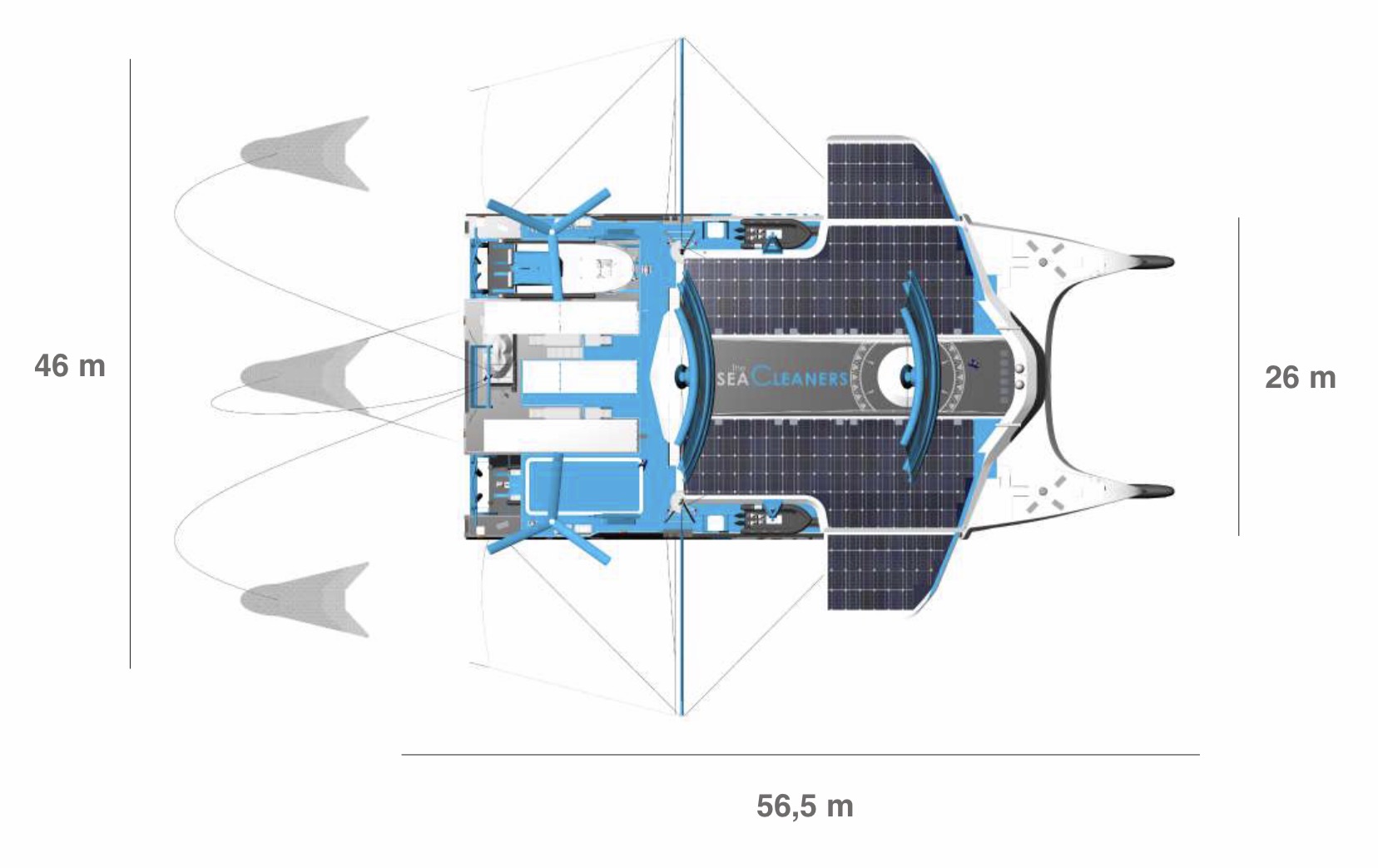
The Manta’s design consolidates performance and simplicity. The Manta ray eats as she swims with her mouth wide open, passing water through her gill arches filtering for zooplankton, jellyfish and crustaceans. The Manta sailboat emulates the manta ray, passing water between its hulls to filter for plastic pollution feeding its waste-to-energy conversion unit to create energy for its propulsion system, and in turn, accomplishing its principal mission of “cleaning the seas”. Source: TheSeaCleaners.org
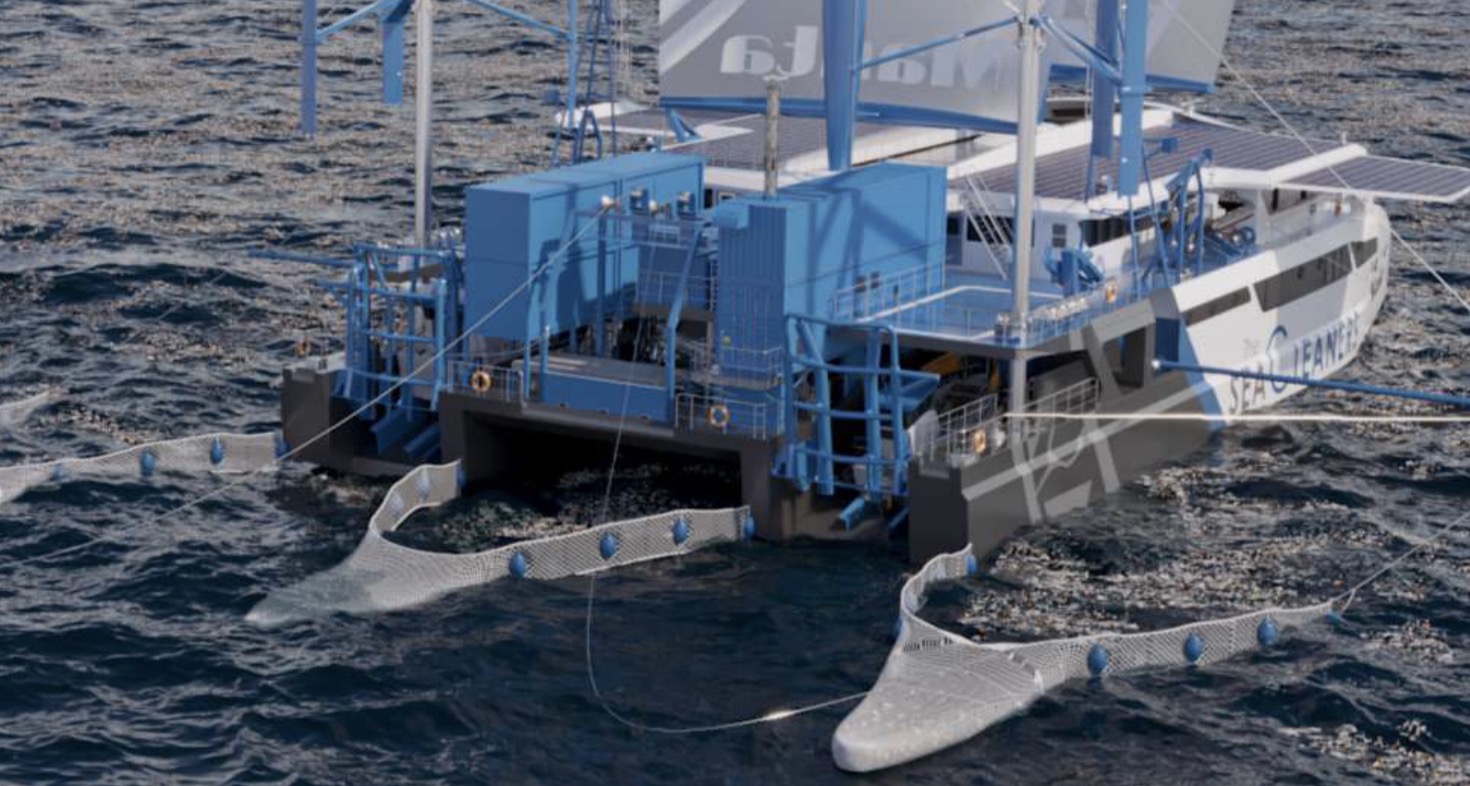
Three floatables collection system – One central and two lateral towed by two outriggers on each side of the Manta. They give the Manta a collection span of 46 meters and a collection depth of one meter, for maximum efficiency in the collection of floating waste, without harming marine fauna and flora. Two cranes located on the main working deck on either side of the ship extract large debris. For their operation, divers can intervene from a tender boat. Source: TheSeaCleaners.org
THE MANTA’S ON-BOARD REPURPOSING PLANT: EVERYTHING IS RECOVERED, NOTHING IS WASTED
The Manta will be the world’s largest floating plant operating autonomously at 75% without using fossil fuels. All the while the Manta will handle 100% of the plastic pollution collected.
After being brought on board, the waste is taken to the sorting unit where operators separate it manually according to its nature. Metal, glass or aluminium waste is stored for return to shore and recycling in local waste management channels. Organic matter, such as wood and algae, is returned to the water, respecting the marine fauna and flora. Plastic waste is shredded and compacted to increase their energy efficiency, before feeding the Waste-to- Electricity Conversion Unit.
The focal point is the Waste-to-Electricity Conversion Unit, named WECU, that will convert plastic into electricity, thereby powering all the electrical equipment (cockpit, navigational instruments, batteries, power units and the plant itself) on-board the Manta.
Pyrolysis is used to vaporise the plastic. Since oxygen is not present the materials do not combust thereby producing a synthetic gas « syngas ».
The syngas engages the turbine and produces electricity.
The heat and toxic emissions released by this process are recovered to meet thermal requirements and maintain a minimum environmental footprint.
The solid carbon residues which represent 5 to 10 % of the treated plastic, will be stored and distributed to recycling management services on land to produce products, such as, bitumen, cement, and fuel.
The pyrolysis process was selected because everything collected and processed on-board will be converted into a useful component. The simple principle – nothing will be wasted – is upheld.
The priority is to covert plastic into usable energy rather than storage, which increases the weight of the sailboat and therefore its energy consumption.
Source: TheSeaCleaners.org
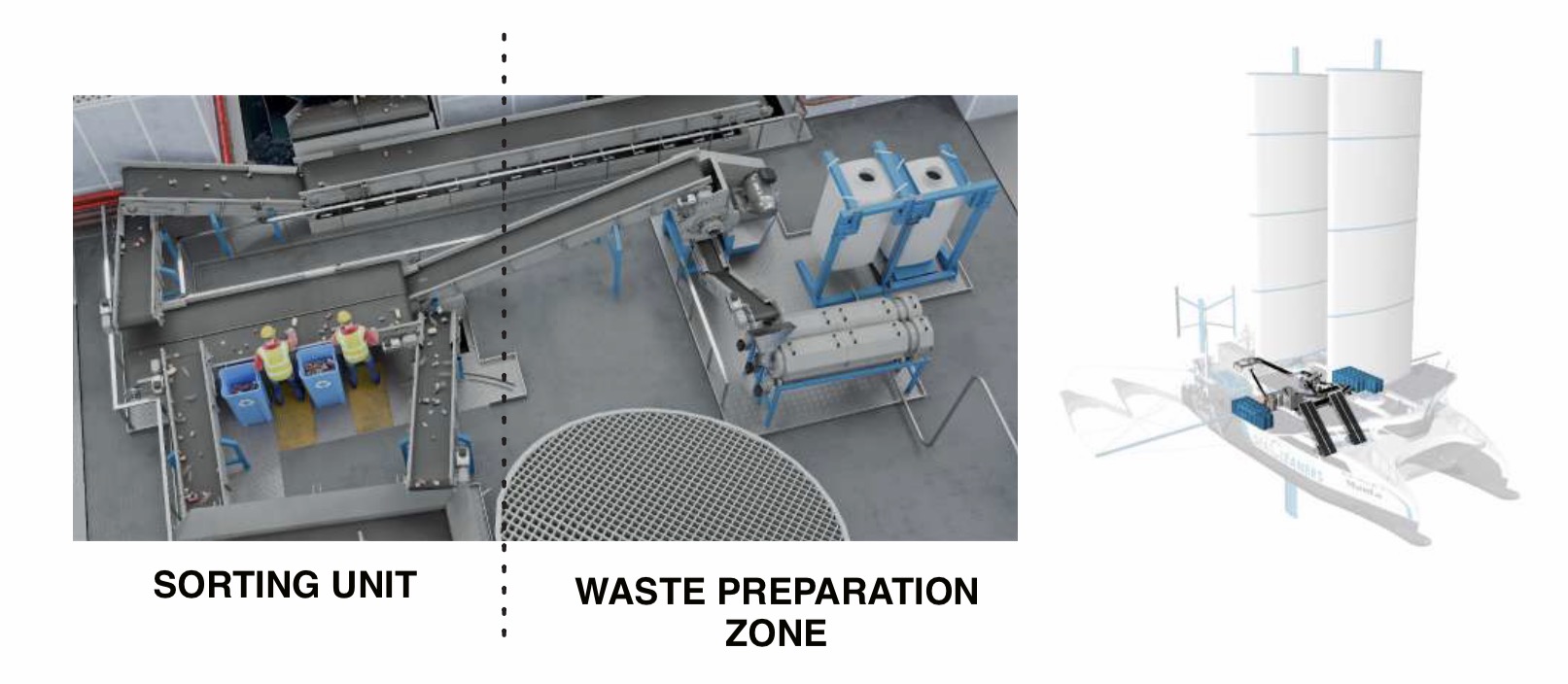
After being brought on board, the waste is taken to the sorting unit where operators separate it manually according to its nature. Metal, glass or aluminium waste is stored for return to shore and recycling in local waste management channels. Organic matter, such as wood and algae, is returned to the water, respecting the marine fauna and flora. Plastic waste is shredded and compacted to increase their energy efficiency, before feeding the Waste-to- Electricity Conversion Unit. Source: TheSeaCleaners.org
THE MANTA: OPERATING AUTONOMOUSLY AT 75% WITHOUT FOSSIL FUELS
Factory boat, ambassador ship, all-in-one plastic decontamination, extraordinary catamaran… the Manta is the epitome of an ecofriendly sailboat.
A sailboat, above all
The Manta’s preferred propulsion mode will be its sails and rigs, minimizing its energy consumption, its carbon footprint and its operating costs. It will maintain a high level of energy autonomy and will function 75% of the time without fossil fuels, thus becoming the first workboat with such a high level of energy autonomy.
A custom-made hybrid propulsion
Because some of its missions require low speeds, the Manta’s hybrid propulsion system allows movement at low speeds (between 2 and 3 knots) while maintaining maneuverability. An optimal way to combine propeller propulsion units driven by electric motors and automated rigs, equipped with a very large sail area (over 1,500 m2). The latter are improved Dynarig rigs, specially designed to reduce the energy bill and the ecological footprint of sailing yachts.
On-board renewable energies: 500 kW in total
The Manta will be equipped with on-board renewable resources that will supply electricity. The goal is to increase self- sufficiency with minimal environmental impact and reduce consumption of fossil fuels.
- Two wind turbines, located at the stern, will generate up to 100 kW of electricity;
- Nearly 500 m2 of photovoltaic solar panels, installed at the bow, will generate approximately 100 kWp (kilowatt-peak) of electricity.
Two-thirds of the panels will be installed on a fixed surface, one-third of the panels will be located on retractable wings. These wings render the appearance of the ray, hence the name the Manta.
- Two hydro-generator, located under the vessel, will generate up to 100 kW by means of their rotors when the boat is under sail propulsion.
- The Waste-to-Electricity Conversion Unit will generate up to 100 kW
In accordance with international regulatory requirements, the Manta is also fitted with two diesel engines to ensure low-speed manevering and ensure safety of the crew.
An upstanding and ecofriendly pyrolysis system
The Manta’s principles of energy management are efficiency and simplicity. Pyrolysis consolidates these principles and is the cleanest and most ecofriendly technology available for processing and recovering plastic waste. The toxic emissions released by this process are treated by an innovative filtration system, thereby, minimizing CO2 and other pollutant into the air.
This filtration system conforms to the strictest standards of the European regulatory requirements. It is the cleanest and most environmentally friendly technology for processing and recovering collected plastic waste, with very low external emissions. In this sense, pyrolysis meets the principles of sobriety and efficiency in energy management on board the Manta.
Source: TheSeaCleaners.org

Between 0,41 and 4 million tons of pollution present in the oceans come from rivers. According to researchers, 88% to 95% of the pollution originates from 10 of the most polluted rivers in the world, mainly in Asia and Africa. Source: TheSeaCleaners.org
ACT WHERE IT’S URGENT
The Manta is the only deep-sea vessel capable of traversing the oceans nonstop, to intervene rapidly anywhere in the world and address areas polluted following natural or climate disasters.
The Manta will be able to intervene to:
Endemic polluted areas: an ocean-going vessel, capable of crossing the oceans non- stop, the Manta will, above all, have a coastal action.
To be effecient, it will intervene in coastal areas where the concentration of waste is the densest, i.e. in the estuaries or mouths of the most polluted and polluting rivers.
Well established studies indicate that 80% of marine pollution begins on land and enters the water ways that lead to the oceans.
Between 0,41 and 4 million tons of pollution present in the oceans come from rivers. According to researchers, 88% to 95% of the pollution originates from 10 of the most polluted rivers in the world, mainly in Asia and Africa.
The 10 most plastic-polluted rivers
- THE YANGTZE
- THE YELLOW RIVER
- THE HAI RIVER
- THE ZHUJIANG
- THE INDUS
- THE AMURP
- THE MEKONG
- THE GANGES
- THE NILE
- THE NIGER
Areas ravaged by natural disasters: hurricanes and tsunamis cause massive inflows of pollution into the ocean. It’s imperative that this pollution is dealt with quickly before it drifts, disperses, sinks and becomes irrecoverable.
The only sailing ship in the world capable of being entrusted with this kind of mission, the Manta will, therefore, prove beneficial to respond rapidly in response to natural or climatic disasters.
Areas of intervention will be targeted through satellite images obtained by collaborative partners, and through exploratory missions carried out by the association. The SeaCleaners will also rely on data provided by the goodwill of other specialised associations and organisations supporting clean- up efforts.
Source: TheSeaCleaners.org
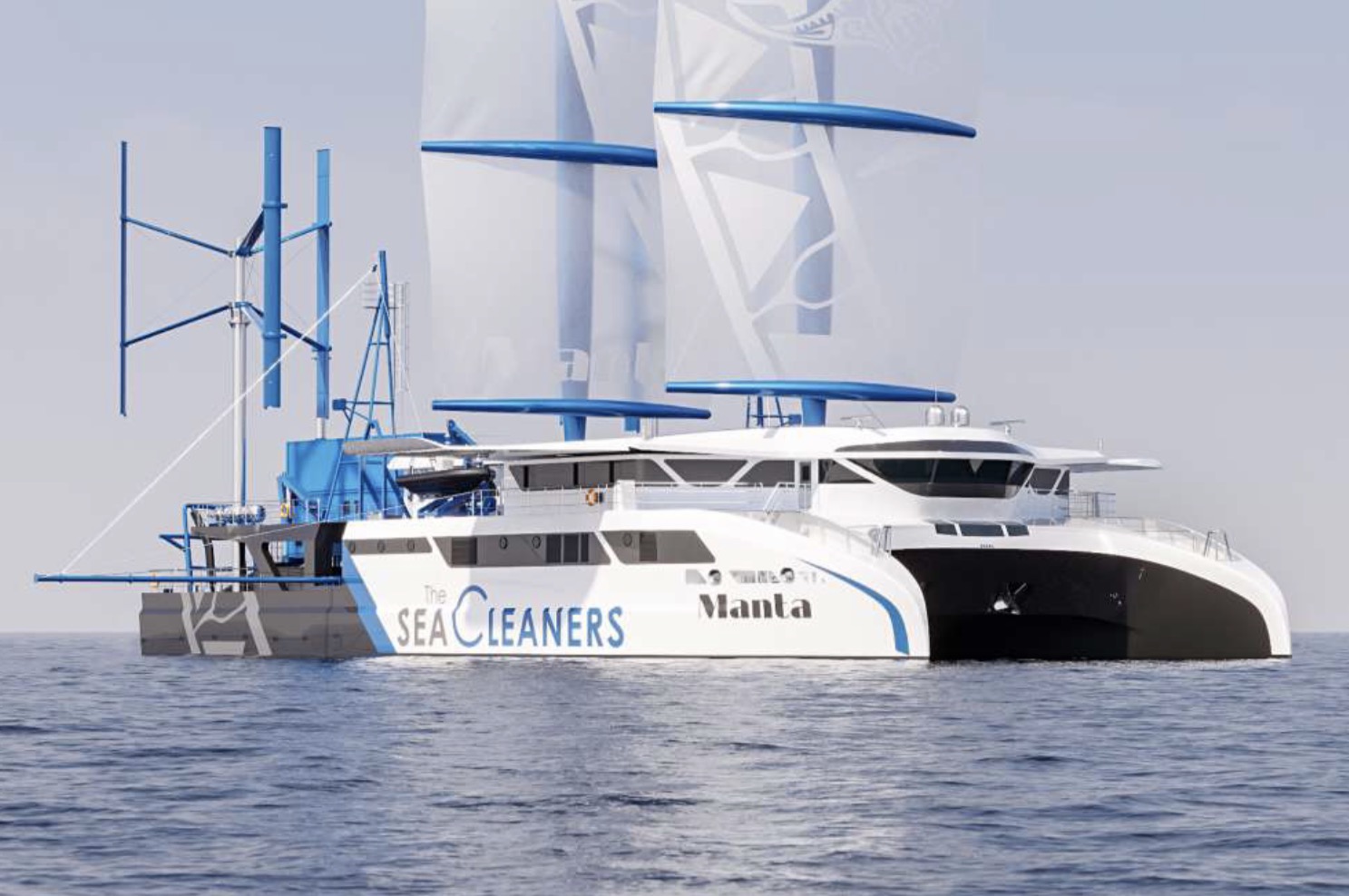
The SeaCleaners: It takes concrete action to prevent and mitigate plastic pollution. We collect floating plastic waste in high concentration areas before it sinks or breaks down into microplastics. We contribute to scientific knowledge through research and open data sharing. We alleviate the problem at its source through education and public awareness initiatives. We carry out
waste collection operations with our teams of volunteers. We support the transition to a circular economy by developing
and demonstrating innovative and ecofriendly technological solutions. Source: TheSeaCleaners.org

Source: TheSeaCleaners.org

